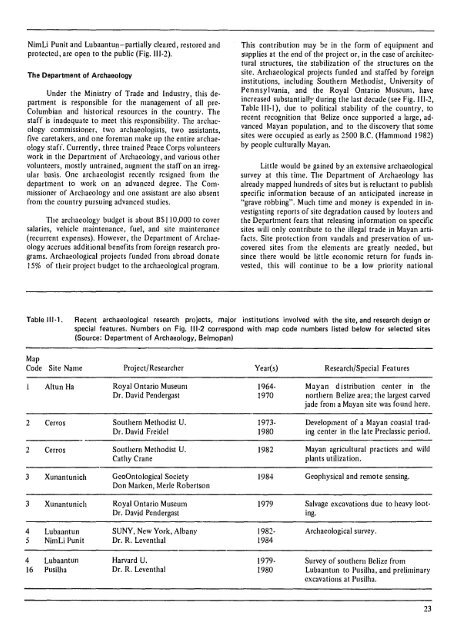Belize
Belize
Belize
You also want an ePaper? Increase the reach of your titles
YUMPU automatically turns print PDFs into web optimized ePapers that Google loves.
NimLi Punit and Lubaantun-partially cleared. restored and<br />
protected. are open to the public (Fig. 111-2).<br />
The Department of Archaeology<br />
Under the Ministry of Trade and Industry. this department<br />
is responsible for the management of all pre<br />
Columbian and historical resources in the country. The<br />
staff is inadequate to meet this responsibility. TIlC archaeology<br />
commissioner. two archaeologists, two assistants,<br />
five caretakers. and one foreman make up the entire archaeo!ogy<br />
stafr'. Currently. three trained Peace Corps volunteers<br />
work in the Department of Archaeology. and various other<br />
volunteers, mostly untrained, augment the staff on an irregular<br />
basis. One archaeologist recen tly resigned frum thl'<br />
department to work on an advanced degree. The Commissioner<br />
of Archaeology and one assistant are also absent<br />
from the country pursuing advanced studies.<br />
The archaeology budget is about 135110,000 to cover<br />
salaries, vehicle maintenance, fuel, and site maintenance<br />
(recurrent expenses). However, the Department of Archaeology<br />
accrues additional benefits from foreign research programs.<br />
Archaeological projects funded from abroad donate<br />
15% of their project budget to the archaeological program.<br />
This contribution may be in the form of equipment and<br />
supplies at the end of the project or, in the case of architectural<br />
structures, the stabilization of the structures on the<br />
site. Archaeological projects funded and staffed by foreign<br />
institutions, including Southern Methodist, University of<br />
Pennsylvania, and the Royal Ontario Museum, have<br />
increased substantia":' during the last decade (see Fig. 1lI-2,<br />
Table III-I), due to political stability of the country, to<br />
recent recognition that <strong>Belize</strong> once supported a large, advanced<br />
Mayan population, and to the discovery that some<br />
sites were occupied as early as 2500 13.c. (Hammond 1982)<br />
by people culturally Mayan.<br />
Little would be gained by an extensive archaeological<br />
survey at this time. The Department of Archaeology has<br />
already mapped hundreds of sites but is reluctant to publish<br />
specific information because of an anticipated increase in<br />
"grave robbing". Much time and money is expended in investigating<br />
reports of site degradation caused by looters and<br />
the Department fears that releasing information on specific<br />
sites will only contribute to the illegal trade in Mayan artifacts.<br />
Site protection from vandals and preservation of uncovered<br />
sites from the elements arc greatly needed, but<br />
since there would be little economic return for funds invested,<br />
this will continue to be a low priority national<br />
Table" 1-1. Recent archaeological research projects, major institutions involved with the site, and research design or<br />
special features. Numbers on Fig. "1-2 correspond with map code numbers listed below for selected sites<br />
(Source: Department of Archaeology, Belmopan)<br />
Map<br />
Code Site Name<br />
Ahun Ha<br />
2 Cerros<br />
2 Cerros<br />
3 Xunantunich<br />
3 Xunantunich<br />
4 Lubaantun<br />
5 NimLi Punit<br />
4 Lubaantun<br />
16 Pusilha<br />
Project/Researcher<br />
Royal Ontario Museum<br />
Dr. David Pendergast<br />
Southern Methodist U.<br />
Dr. David Freidel<br />
Southern Methodist U.<br />
Cathy Crane<br />
GeoOntological Society<br />
Don Marken, Merle Robertson<br />
Royal Ontario Museum<br />
Dr. David Pendergast<br />
SUNY, New York, Albany<br />
Dr. R. Leventhal<br />
Harvard U.<br />
Dr. R. Leventhal<br />
Year(s)<br />
1964-<br />
1970<br />
1973-<br />
1980<br />
1982<br />
1984<br />
1979<br />
1982-<br />
1984<br />
1979-<br />
1980<br />
Research/Special Features<br />
Mayan distribution center in the<br />
northern 13elize area; the largest carved<br />
jade from a Mayan site was found here.<br />
Development of a Mayan coastal trading<br />
center in the late Preclassic period.<br />
Mayan agricultural practices and wild<br />
plants utilization.<br />
Geophysical and remote sensing.<br />
Salvage excavations due to heavy looting.<br />
Archaeological survey.<br />
Survey of southern 13elize from<br />
Lubaantun to Pusilha, and preliminary<br />
excavations at Pusilha.<br />
23

















